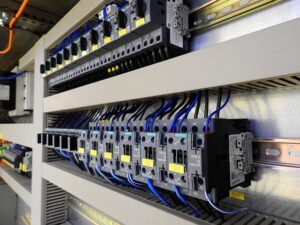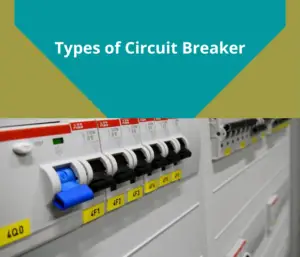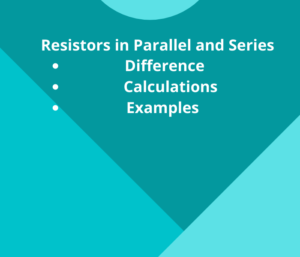I can’t forget the factory I worked at during my post-graduation period—it was a plastic pipes factory that relied on solid-state relays to control production line heaters, with many of them rapidly switching on and off in control panels.
The most important task in the factory was checking these relays hourly. We used a current clamp meter to verify if the SSRs were working correctly.
It’s been more than 15 years since I left that factory for a better opportunity, and recently, I decided to delve into some research on SSRs. I discovered some basic yet crucial questions you should know.
Table of Contents
how does a solid state relay work?
A Solid-State Relay (SSR) is an electronic switching device that uses semiconductor components, typically integrated circuits (ICs), to perform the switching operation without any moving parts. The working principle of a Solid-State Relay involves the following key components and steps:
- Input Section:
- The input section of an SSR typically consists of an optocoupler or opto-isolator. This component isolates the control (input) and load (output) sections of the relay. It uses a light-emitting diode (LED) on the control side and a photodetector (such as a photodiode or phototransistor) on the load side. When a control signal is applied, the LED emits light, which is then detected by the photodetector.
- Optical Isolation:
- The use of an optocoupler ensures electrical isolation between the input and output sections. This isolation helps prevent issues like ground loops and enhances the safety of the relay in applications where isolation is critical.
- Control Signal:
- The control signal, often a low-voltage DC signal, activates the LED in the optocoupler. The intensity of the light emitted by the LED is proportional to the control signal.
- Output Section:
- The photodetector in the load section converts the received light signal into an electrical signal. This signal is then used to control a semiconductor switch in the output section.
- Semiconductor Switching:
- The output section usually employs a semiconductor device, such as a thyristor (SCR), triac, or power MOSFET, as the switching element. When the control signal is applied and the photodetector produces an output, the semiconductor switch is triggered to conduct, allowing current to flow through the load circuit.
- Load Circuit:
- The load circuit is the external electrical circuit connected to the output section of the SSR. It could be a resistive, inductive, or capacitive load, depending on the application.
- Switching Operation:
- The semiconductor switch controls the flow of current in the load circuit. When the control signal is active, the SSR conducts, allowing current to flow. Conversely, when the control signal is inactive, the SSR turns off, interrupting the current flow.
- Advantages:
- SSRs offer advantages over traditional electromechanical relays, including faster switching speeds, longer lifespan (no moving parts to wear out), reduced electromagnetic interference (EMI), and silent operation.
In summary, the working principle of a Solid-State Relay involves using an optocoupler to provide electrical isolation and a semiconductor switch to control the current flow in the load circuit based on the input control signal.
mechanical vs solid state relay
| Relays | Solid-State Relay |
| The relays are “Control switch” that does the switching process by changing the position of the contact points. | Solid-State relay is the “Control Switch” that does the switching process without using any kind of “contact” points or movable parts. |
| The relay uses “the electro-mechanical” coil or other parts for the switching process. | The signals of photocoupler become the reason for the switching. |
| The energize or de-energize process makes or breaks the circuit. | The input voltage at the control terminals makes (close) or breaks the circuit. |
| The operating voltages range from 12-120V. | The operating voltage ranges vary for different mounting types. |
| These relays are inexpensive. | Solid-state relay is relatively expensive. |
| It is a mechanical device. | The solid-state relay does not have any parts that move. |
| Very much feasible for the AC circuits. | More reliable for the electronic circuits. But still works for AC circuits |
| The parts of these relays wear out and start adding more bouncing effect than new relay after a certain time. | These relays do not age. |
| These are age-limited and have to be replaced after some time. | These relays last very much longer than the elctro-mechanical relays and render long last reliability. |
| These relays have coils and flaps for switching purposes. | These relays have thyristors, TRIAC(s), and transistors. |
| Noisy switching is done, adds noise when used in the electronic circuit. | Does not add noise and has low EMI (Electro-Magnetic Interference). |
| Switches take time to respond to the input signals. | Switching is done by light signals and the speed of switching is way much more than other relays. |
| Types:(on the basis of working principle) General-purpose relays Machine control relays Reed relays | Types: (on the basis of working principle) Zero-Switching relays Analog-Switching relays Peak-Switching relays Instant ON relays. |
what is a solid state relay used for?
Solid-State Relays (SSRs) are used in a variety of applications across different industries due to their numerous advantages over traditional electromechanical relays. Some common uses of SSRs include:
- Industrial Automation:
- SSRs are widely used in industrial automation for controlling various processes, such as heating elements, motors, and solenoids. Their fast switching speeds and reliability make them suitable for precise control in manufacturing and processing systems.
- Temperature Control Systems:
- SSRs are employed in temperature control systems for applications like ovens, furnaces, and environmental chambers. They can accurately regulate the power supplied to heating elements, maintaining a consistent temperature.
- Lighting Control:
- In lighting systems, SSRs are used for dimming and controlling the intensity of lights. They provide smooth and silent operation, making them suitable for applications where noise is a concern.
- Power Supplies:
- SSRs can be used in power supply circuits to control the output voltage or current. They are effective in applications requiring precise and fast adjustments to power levels.
- Motor Control:
- SSRs find applications in motor control circuits, particularly for smaller motors. They can be used to start, stop, or regulate the speed of motors in various machinery.
- Switching Power Supplies:
- SSRs are utilized in switching power supplies to control the delivery of power to electronic devices. Their ability to switch rapidly and handle high frequencies makes them suitable for power supply applications.
- Medical Equipment:
- SSRs are used in medical devices and equipment where reliability and precise control are critical. Applications include patient monitoring systems, diagnostic equipment, and laboratory instruments.
- Photovoltaic Systems:
- In solar power systems, SSRs are employed for switching and controlling the flow of electrical energy. They help manage the connection and disconnection of solar panels, inverters, and batteries.
- Test and Measurement Equipment:
- SSRs are utilized in electronic test and measurement equipment for switching and controlling signals. They provide a reliable and noise-free switching mechanism in applications where accuracy is essential.
- Telecommunications:
- SSRs are used in telecommunications equipment for switching and controlling electrical signals. Their reliability and ability to handle high-frequency signals make them suitable for various applications in this field.
- HVAC (Heating, Ventilation, and Air Conditioning) Systems:
- SSRs are employed in HVAC systems for controlling components such as heating elements and fans. Their precise control helps in maintaining optimal environmental conditions.
In summary, Solid-State Relays find applications in diverse industries where fast and reliable switching, precise control, and long lifespan are essential.
Their use extends across automation, energy management, electronics, and other fields where electrical control is necessary.
Why Does Solid-State Relay has no Mechanical Vibration?
Solid-State Relays (SSRs) do not have mechanical parts, such as coils and contacts, which are present in traditional electromechanical relays.
The absence of these mechanical components is a key reason why SSRs do not exhibit mechanical vibration. Here’s a breakdown of why SSRs are free from mechanical vibration:
- No Moving Parts:
- Unlike electromechanical relays that have moving parts like springs, contacts, and coils, SSRs are entirely electronic. SSRs use semiconductor devices, such as thyristors or triacs, to switch the electrical load. The absence of moving parts eliminates the mechanical motion that typically leads to vibration in traditional relays.
- Semiconductor Switching:
- SSRs use semiconductor components to control the switching operation. When the control signal is applied, the semiconductor switch turns on or off, allowing or interrupting the flow of current. This process is achieved without any physical movement, resulting in a smooth and vibration-free operation.
- Silent Operation:
- The solid-state nature of SSRs makes them operate silently. There are no audible clicks or vibrations associated with the mechanical movement of components, as seen in electromechanical relays. This characteristic is particularly advantageous in applications where noise is a concern, such as in audio systems or quiet environments.
- Reduced Wear and Tear:
- Mechanical relays are prone to wear and tear over time due to the constant movement of their components. In contrast, SSRs have a longer lifespan because they lack these moving parts that can degrade with use. The absence of mechanical wear contributes to the reliability and durability of SSRs.
- Faster Switching Speeds:
- SSRs can switch on and off much faster than electromechanical relays. The absence of mechanical components means there are no physical limitations on the switching speed. This rapid switching capability is advantageous in applications requiring precise and fast control, such as in industrial automation.
- Less Maintenance:
- The solid-state design of SSRs results in lower maintenance requirements compared to mechanical relays. With no mechanical parts to inspect, adjust, or replace, SSRs are more reliable over extended periods, reducing the need for regular maintenance interventions.
In summary, the absence of mechanical parts in Solid-State Relays eliminates the sources of mechanical vibration associated with traditional electromechanical relays. This contributes to the silent, reliable, and maintenance-friendly operation of SSRs in various applications.
Do Solid-State relays fail open or closed?
Solid-State Relays (SSRs) can fail in either the open or closed state, depending on the type of failure and the design of the relay. Here are the two primary failure modes:
- Fail-Open:
- In a fail-open scenario, the SSR fails in such a way that the output circuit becomes open, meaning that there is no electrical continuity between the input and output terminals. This failure mode can occur due to a fault in the semiconductor switching component, such as a failure in the thyristor or triac. Fail-open conditions are generally considered safer in many applications, as an open circuit would interrupt the flow of current, preventing unintended activation of the load.
- Fail-Closed:
- Conversely, in a fail-closed scenario, the SSR fails in a way that the output circuit becomes closed, maintaining electrical continuity between the input and output terminals. Fail-closed conditions are less common and can be associated with specific failure modes in the semiconductor switch. In this scenario, the load may remain energized even when the control signal is not applied.
It’s important to note that the specific failure mode of an SSR can depend on the design, quality, and manufacturing of the relay.
Manufacturers may implement fail-safe mechanisms or protection features to mitigate the impact of potential failures. Some SSRs incorporate features like built-in snubbers, overvoltage protection, and thermal protection to enhance reliability and safety.
When selecting an SSR for a particular application, it’s advisable to consider the relay’s datasheet and specifications to understand its behavior under fault conditions.
Additionally, incorporating redundancy or backup systems in critical applications can provide an extra layer of protection against potential relay failures.
Does Solid-State Relay get hot?
Yes, Solid-State Relays (SSRs) can generate heat during operation, primarily due to the characteristics of the semiconductor devices used within them.
The amount of heat produced depends on factors such as the load current, the switching frequency, and the design of the SSR. Here are some key points regarding the heat generated by SSRs:
- Semiconductor Switching Components:
- SSRs use semiconductor devices, such as thyristors, triacs, or power MOSFETs, in their output circuit. When these devices are switched on, they exhibit a certain amount of resistance, leading to power dissipation and the generation of heat.
- Load Current:
- The magnitude of the load current passing through the SSR affects the amount of heat generated. Higher load currents result in greater power dissipation and, consequently, more heat. It’s essential to ensure that the SSR is rated appropriately for the intended load.
- Switching Frequency:
- The switching frequency of the SSR can impact the heat generation. Higher switching frequencies, especially in applications where the SSR rapidly turns on and off, can contribute to increased power dissipation and heat.
- Heat Sink:
- Some SSRs are designed with integrated heat sinks or are meant to be mounted on external heat sinks. Heat sinks help dissipate the generated heat into the surrounding environment, preventing the SSR from reaching excessive temperatures. The choice of an appropriate heat sink is crucial for maintaining the SSR’s operating temperature within safe limits.
- Ambient Temperature:
- The ambient temperature in which the SSR operates also plays a role. Higher ambient temperatures reduce the ability of the SSR to dissipate heat, potentially leading to an increase in the device’s temperature.
- Derating:
- Manufacturers often provide derating curves in SSR datasheets, indicating how the SSR’s maximum load current capacity should be reduced at higher temperatures. Following these derating guidelines is important for preventing overheating.
While SSRs can become warm during normal operation, excessive heat can be a concern if not properly managed.
Adequate heat sinking, proper derating, and adhering to the manufacturer’s specifications are essential to ensure reliable and safe operation of Solid-State Relays.
Why does a solid state relay fail?
Solid-State Relays (SSRs) can fail for various reasons, and the specific cause of failure may depend on factors such as the application, environmental conditions, and the quality of the SSR. Here are some common reasons why a Solid-State Relay might fail:
- Overheating:
- Excessive heat is a significant factor in SSR failure. If the SSR is not adequately heat-sinked or the ambient temperature is too high, the internal components may overheat, leading to degradation or failure of the semiconductor switching devices.
- Overvoltage or Voltage Spikes:
- SSRs can be sensitive to overvoltage or voltage spikes. High voltage transients, whether caused by the load or the electrical environment, can damage the semiconductor components within the SSR, leading to failure.
- Overcurrent:
- Operating the SSR above its rated current capacity can cause overheating and damage. Overcurrent conditions may occur due to a short circuit in the load or exceeding the SSR’s specified current limits.
- Voltage and Current Ratings Exceedance:
- Using an SSR outside its specified voltage or current ratings can lead to failure. It’s crucial to match the SSR’s specifications to the requirements of the application.
- Improper Mounting:
- Incorrect or inadequate mounting can impact the SSR’s ability to dissipate heat. If the SSR is not mounted on an appropriate heat sink or if the heat sink is not properly attached, it can lead to overheating and failure.
- Environmental Factors:
- Environmental conditions, such as high humidity, corrosive atmospheres, or exposure to contaminants, can contribute to SSR failure. Moisture and contaminants may affect the electrical insulation and reliability of the SSR.
- Manufacturing Defects:
- Defects introduced during the manufacturing process, such as poor soldering, incorrect assembly, or substandard components, can lead to SSR failures. Quality control measures are critical to minimizing manufacturing-related failures.
- Thermal Cycling:
- SSRs subjected to frequent thermal cycling, where they experience rapid heating and cooling, may be prone to failure over time. This can be a concern in applications with frequent on/off cycles.
- Age and Wear:
- Like any electronic device, SSRs have a finite lifespan. Over time, the semiconductor components can degrade, reducing the reliability of the SSR. This aging process is typically gradual but can lead to eventual failure.
- External Interference:
- Electromagnetic interference (EMI) or radiofrequency interference (RFI) from external sources can impact the operation of SSRs. Proper shielding and isolation measures are essential to mitigate these effects.
To prevent SSR failures, it’s crucial to follow the manufacturer’s guidelines, use SSRs within their specified ratings, provide adequate cooling, and consider the environmental conditions of the application.
Regular maintenance and monitoring can help detect issues early and prevent catastrophic failures.
Don’t Leave Empty-Handed!
Install my Free Android App on Google Play:
Electrical Cables Most Common Tables “Cables Tables”
And, my Electrical Calculations App “Fast Electrical Calculator”
Discover more great content by subscribing to My channel
Looking to stay ahead of the game in the world of electrical engineering? Subscribe to my YouTube channel and gain access to exclusive content you won’t find anywhere else!
The staff I recommend
(Amazon Affiliate Links to products I believe are high quality):
- Economy 120 Volt/60Hz AC Power Source – Step-Down Voltage & Frequency Converters 1800W
- UNI-T Digital Multimeter Tester UT139C
- 50-Amp Extension Cord for RV “100ft”
- Voltage Stabilizer 110/220v
- Hair Dryer “best selling“
- TOSHIBA EM131A5C-BS Countertop Microwave Ovens
Disclaimer: This contains affiliate links to Amazon products. I may earn a commission for purchases made through these links.




